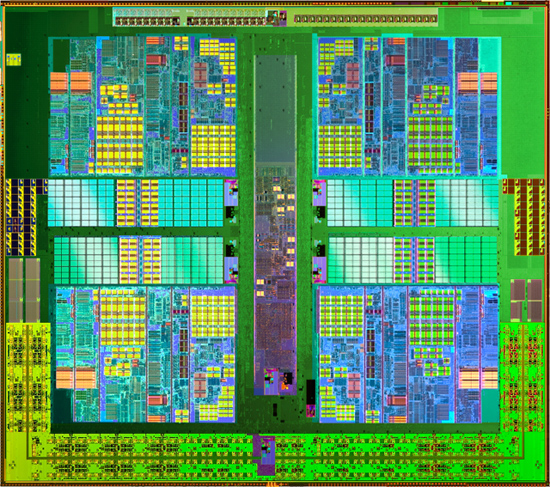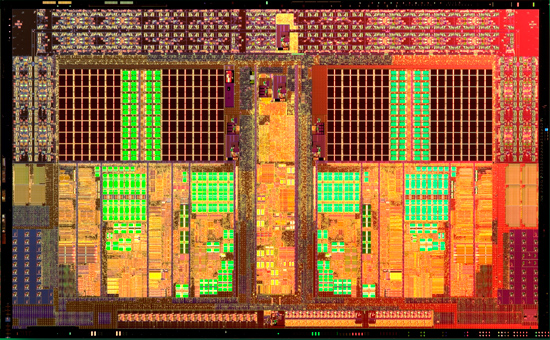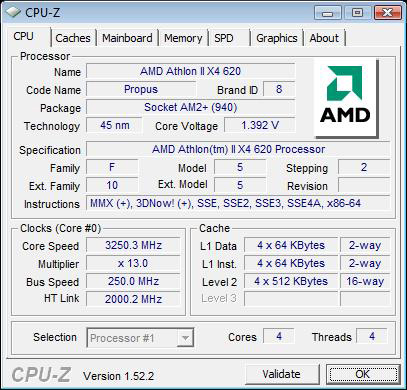AMD Athlon II X4 620 & 630: The First $99 Quad Core CPU
by Anand Lal Shimpi on September 16, 2009 12:00 AM EST- Posted in
- CPUs
How does AMD respond to Lynnfield? Is it by drastically cutting prices on Phenom II? Nope. By introducing the world’s first quad-core processor to debut at $99. Now that’s cool.

It’s called the Athlon II X4 and its existence shouldn’t be any surprise. AMD quietly announced it along with the Athlon II X2 line.

Today we get two models: the Athlon II X4 630 and the Athlon II X4 620, priced at $122 and $99 respectively. The only difference between the two is clock speed; the 630 runs at 2.8GHz while the 620 runs at 2.6GHz. These are both AM3 chips meaning they'll work in AM3 motherboards with DDR3 memory or AM2+ boards with DDR2 memory.
| Processor | Clock Speed | L2 Cache | L3 Cache | TDP | Price |
| AMD Phenom II X4 965 BE | 3.4GHz | 2MB | 6MB | 140W | $245 |
| AMD Phenom II X4 955 BE | 3.2GHz | 2MB | 6MB | 125W | $245 |
| AMD Phenom II X4 945 | 3.0GHz | 2MB | 6MB | 125W | $225 |
| AMD Phenom II X3 720 BE | 2.8GHz | 1.5MB | 6MB | 95W | $145 |
| AMD Phenom II X2 550 BE | 3.1GHz | 1MB | 6MB | 80W | $105 |
| AMD Athlon II X4 630 | 2.8GHz | 2MB | 0MB | 95W | $122 |
| AMD Athlon II X4 620 | 2.6GHz | 2MB | 0MB | 95W | $99 |
| AMD Athlon II X2 250 | 3.0GHz | 2MB | 0MB | 65W | $87 |

This isn’t a harvested Phenom II nor is it a pair of Athlon II X2s, instead it looks like we have a brand new die on our hands (some Athlon II X4s will be crippled Phenom IIs but AMD insists that the new die will be used). The Athlon II X4 has four cores on a single die, but unlike the Athlon II X2 each core only has a 512KB L2 per core. You can tell by the die shot that the core-to-cache ratio is much higher than on the X2:

The 45nm Athlon II X4 Propus die

The 45nm Athlon II X2 die (note the larger L2 per core)
Like the rest of the Athlon II lineup there is no L3 cache. This helps keep the die small (and affordable) but also hurts performance:
| Processor | SYSMark 2007 Overall | E-Learning | Video Creation | Productivity | 3D |
| AMD Phenom II X4 920 (2.8GHz) | 173 | 151 | 212 | 167 | 167 |
| AMD Athlon II X4 630 (2.8GHz) | 157 | 128 | 221 | 131 | 162 |
| % of Phenom II X4 | 91% | 85% | 104% | 78% | 97% |
At the same clock speed the Athlon II X4 should offer roughly 90% of the performance of a Phenom II X4.
| Processor | Cores | Manufacturing Process | L1 Cache | L2 Cache | L3 Cache | Die Size | Transistor Count |
| AMD Phenom II X4 | 4 | 45nm | 128KB per core | 512KB per core | 6MB | 258 mm2 | 758M |
| AMD Athlon II X4 | 4 | 45nm | 128KB per core | 512KB per core | 0MB | 169 mm2 | 300M |
| AMD Athlon II X2 | 2 | 45nm | 128KB per core | 1MB per core | 0MB | 117 mm2 | 234M |
| Intel Core 2 Quad Q8xxx | 4 | 45nm | 64KB per core | 4MB | 0MB | 164 mm2 | 456M |
The price is unbeatable. If we ignore the 630 for a moment, the Athlon II X4 620 is by far the cheapest route to four cores on the market. Intel’s most affordable quad-core is the Core 2 Quad Q8200 at $163, while AMD would previously charge you $163 for a Phenom X4 9600B. This is where the AM3/AM2+ compatibility play really helps out. Motherboard/memory costs are as cheap as possible thanks to AMD's incredible socket flexibility.

And just in case you’re wondering, yes, the Athlon II X4 620 actually delivers performance competitive with the Q8200 but for 60% of the cost. It’s not all that clear cut, there are some cases where the 620 is faster but others where the Q8200 is much faster. On average it ends up being a wash but you’ll want to pay attention to the coming pages to see how the cookie crumbles as it does vary from test to test.

Codename Propus
Overclocking isn't unfortunately as good as the Phenom IIs; the result of a conscious design decision or simply the early nature of the Propus die. That being said, without a single extra millivolt I was able to hit 3.25GHz on my Athlon II X4 620 sample - making it even more valuable. Extra voltage proved mostly useless, I could only approach 3.4GHz with an extra 300mV.
Let’s see, have I thoroughly ruined the surprise? Check. Now let’s get to the tests.
The Test
| Motherboard: | Intel DX58SO (Intel X58) Intel DX48BT2 (Intel X48) Gigabyte GA-MA790FX-UD5P (AMD 790FX) |
| Chipset: | Intel X48 Intel X58 AMD 790FX |
| Chipset Drivers: | Intel 9.1.1.1015 (Intel) AMD Catalyst 8.12 |
| Hard Disk: | Intel X25-M SSD (80GB) |
| Memory: | Qimonda DDR3-1066 4 x 1GB (7-7-7-20) Corsair DDR3-1333 4 x 1GB (7-7-7-20) Patriot Viper DDR3-1333 2 x 2GB (7-7-7-20) |
| Video Card: | eVGA GeForce GTX 280 |
| Video Drivers: | NVIDIA ForceWare 180.43 (Vista64) NVIDIA ForceWare 178.24 (Vista32) |
| Desktop Resolution: | 1920 x 1200 |
| OS: | Windows Vista Ultimate 32-bit (for SYSMark) Windows Vista Ultimate 64-bit |










150 Comments
View All Comments
fitten - Wednesday, September 16, 2009 - link
Your definition of "overclocked" is flawed. Back under the bridge with you!philosofa - Wednesday, September 16, 2009 - link
Can someone please ban this moron, and the others (who ironically I assume are on AMD's payroll?). Their lack of an understanding of the most basic logic is making me feel ill.Good Review though, just really want Bulldozer to come out!
james jwb - Thursday, September 17, 2009 - link
why can't people like you understand what is meant? I can handle my own CPU, so for me, i want to know which one is better clock for clock, and then see what the average each overclock to, then i'll jump in and buy one.The way data is currently being presented here isn't right, we need both ways (stock results with turbo on, and clock for clock style stuff for us overclockers).
Get it now? Probably not.
bupkus - Wednesday, September 16, 2009 - link
"Their lack of an understanding of the most basic logic is making me feel ill."Take a Tums; we're not interested.
rennya - Wednesday, September 16, 2009 - link
Overclocking is not the same as turbo mode.Overclocking voids your warranty, whether you use Intel or AMD CPUs.
Turbo mode doesn't void warranty because it is a valid feature.
SlyNine - Wednesday, September 16, 2009 - link
lol You will make your own little universe in your mind. okay lol.Overclocking. Lets see. Over, meaning above normal. Well since the post turbo mode clock is perfectly normal. Its not OVER clocking.
vol7ron - Wednesday, September 16, 2009 - link
Just because the clock rate is variable, does not mean it's [over/under]clocking. It just means the speeds change. In fact, even when you are running at stock speeds, the clock rate will vary - that is why you see 3.541 3.500 3.489To complain it's not a fair comparison, he's kind of right, but not for the right reason. It's as if he's in AMDs defense, rather than their scrutiny. Instead of comparing peaches-to-peaches, now you're comparing nectarines-to-peaches and there's two ways to look as this glass: Intel is turbo-ing during fewer threads, or Intel is decelerating in multithreaded situations; both have the same effect. (They're either trying to give you more bang for the buck, or they put out a bad product that only works half the time)
The end result, though, AMD doesn't do this on the fly. Sure you could test it at different clock speeds, but you could also overclock the i7 to something faster (and you might be back at square one).
Chlorus - Wednesday, September 16, 2009 - link
"remember that the lynnfield core i7 750 has turbo overclocking enabled so is overclocked to 3.2 ghz, which is 600 mhz overclocking, while amd processors are running at stock speedIs unfair to present the results this way, turbo is overclocking. "
Its not overclocking if ITS ON BY DEFAULT, you worthless troll.
hanhan1982923 - Wednesday, April 14, 2010 - link
22222222222222Thomas369 - Saturday, July 28, 2018 - link
The Athlon architecture also used the EV6 bus licensed from DEC as its main system bus. Intel required licensing to use the GTL+ bus used by its Slot 1 Pentium II and later processors. By licensing the EV6 bus used by the Alpha line of processors from DEC, AMD was able to develop its own chipsets and motherboards, and avoid being dependent on licensing from its direct competitor. https://chasebanklogin.us/chase-credit-card-login/